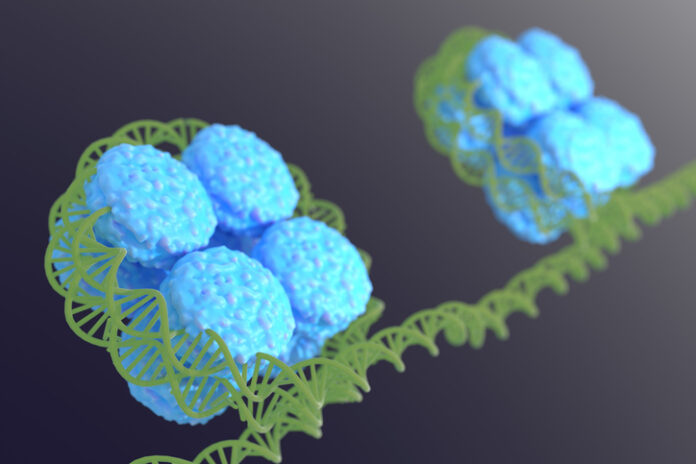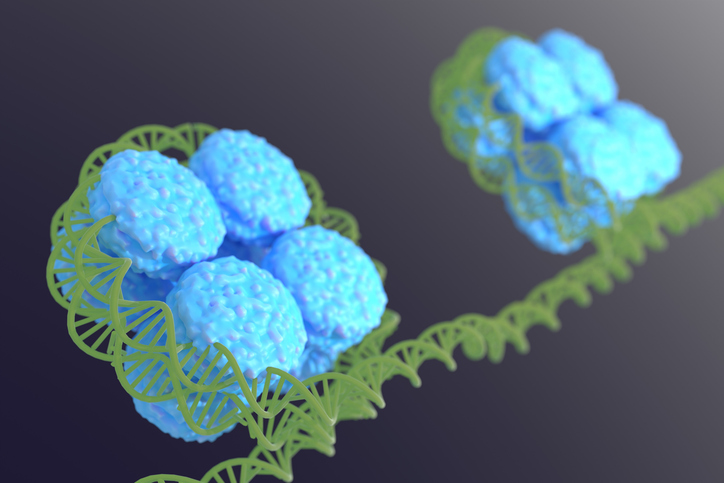 Credit: Sci-Monde / iStock / Getty Images Plus
Credit: Sci-Monde / iStock / Getty Images Plus
Jonathan D. Grinstein, PhD, the North American Editor of Inside Precision Medicine, hosts a new series called Behind the Breakthroughs that features the people shaping the future of medicine. With each episode, Jonathan gives listeners access to their motivational tales and visions for this emerging, game-changing field.
There was tragic biopharma news in mid-June 2025, when this episode was recorded. A second person treated with Elevidys, Sarepta Therapeutics’ gene therapy for Duchenne Muscular Dystrophy (DMD), died from the drug. Just last week, Sarepta announced that a third clinical trial participant with limb-girdle muscular dystrophy died from liver failure caused by the experimental gene therapy, which is also suspected of Elevydis. Genetic medicines are still risky and in development, but difficulties like safety can spur innovation. This is where our special guest for this episode steps in.
After 25 years of leading drug programs in “big pharma,” Amber Salzman, PhD, left GSK after multiple family members were diagnosed with a hereditary neurodegenerative illness. She is currently the CEO of Epicrispr, a biotech company focused on epigenomic modulation, a promising area of genetic medicine. In this episode, Salzman discusses how Epicrispr is using their Gene Expression Modulation System (GEMS) to develop therapeutics for previously untreated genetic disorders, such as those that require finer tuning than simply turning genes on and off, as well as those that are too large for gene replacement, like DMD.
Highlights of this interview have been edited for length and clarity.
IPM: What advantages does epigenetic editing have over DNA editing?
Salzman: There are some serious diseases caused by mutations in large genes that cannot be simply replaced. However, the human body is clever in that it sometimes has a compensatory gene. For example, if you take DMD, dystrophin may be harmful; however, if you could upregulate utrophin, it would be 80% homologous with dystrophin. That could compensate for the lack of dystrophin. That is true for many genetic diseases—not all, but many—where activating a compensatory gene would alleviate the disease.
The main advantage is that it is already expressed in your body. As a result, it reduces safety risks. So that’s just an example of where activation is a superpower. Also, consider haplo-insufficient diseases, in which one allele expresses while the other does not. However, if you could go in and double the expression of the good allele without overexpressing and becoming toxic, that would be one of the superpowers we bring to the table.
IPM: How does Epicrispr develop epigenetic editors?
Salzman: We have a library of hundreds of gene modulators or factors, and some of them methylate, some demethylate, some target histone acetylation, and so on, and the reason we need hundreds is because this is something that I will admit I was naive about because I’m all about indications, and fortunately I’m paired with a great team that is concerned about the infrastructure and the technology, and they’re like, we’re not going to work with just one modulator. The effector that works for bindings at the exact location for Facioscapulohumeral Muscular Dystrophy (FSHD) may not be the best one for another target, even though, as you mentioned, you can screen for different guide RNA, but it’s a combination of the guide RNA and the suppressor in this case. Different diseases require varying levels of suppression.
We perform extensive screening before determining which domains overlap, allowing us to engineer further. We’ve done some machine learning based on the screening to help us engineer and screen even more effectively. So it’s a combination of many things. We began with extensive screening and analysis, followed by machine learning to engineer around it.
One of the things we’re excited about, which we haven’t seen in others, is that some studies have shown that effectors can bind to the Cas molecule, allowing you to activate a gene at high levels if necessary, but this isn’t permanent. So it may last as long as the activator is present, which is approximately 10 to 12 days in vitro, but the activation will eventually wear off. We’ve developed activators that not only activate but do so consistently. We’ve demonstrated that, for example, in vivo and in mice with humanized livers, we can activate, as a proof of concept, LDLR, and that gene remains activated even after the effector is removed, as well as being active and upregulated.
IPM: What are your thoughts on the recent announcements by Sarepta Therapeutics regarding patient deaths?
Salzman: Regarding the very unfortunate deaths in Duchenne, I believe they serve as a reminder that AAV is toxic. We know that. But does anyone claim chemotherapy is safe? No, but we keep using it. Until we have better delivery mechanisms, we must be humble with AAV and choose our patients carefully, just as we do with chemotherapy. You must conduct a risk-benefit analysis of the patients and thoroughly understand what you are doing.
I’ll personalize it. My son went through a bone marrow transplant. I can’t tell you how painful it was to give him chemotherapy, and there were days it was touch-and-go with him. Thank God he’s a thriving 25-year-old now. I wouldn’t change that for a minute. We put him through hell and back again. It’s the same thing with AAV. These are dangerous, but incredibly, they’re almost miracles in what they can do.
I am eager for better, safer ways to deliver what we are doing, but we simply need to be humble, understand what we’re dealing with, and be cautious on the positive side. Look, there were 750 ambulating DMD patients who all performed well. Let me clarify that I am not minimizing the pain and heartbreak of the families who lost two non-ambulating children, and I am sure we are all trying to learn from this. We do have to be concerned about AAV in the same way that many other medicines are, and I use chemotherapy as an example because no one would say it’s safe, but no one would say don’t use it in the right circumstances.
IPM: How are you, at Epicrispr, addressing the safety of your epigenetic editing therapeutic candidates?
Salzman: In terms of what makes us unique in terms of safety, this is why we were moving quickly with the FDA. You have to be concerned about going off target. Even though off-targets are not as dangerous as cutting DNA, you do not want to methylate a region that should not be methylated. Much of your DNA is non-coding. You have to look to see if you’re binding to a place you shouldn’t be and methylating something you shouldn’t be methylating, so we performed a thorough off-target analysis and discussed with the agency which tissues we should be looking at, what thresholds we should be looking at, and how we look at it from a methylation and protein expression perspective. Are we looking at RNA-seq? Are we expressing proteins in a different way? Have we modified it? Have we changed the methylation anywhere and observed any off-target effects? So that’s a unique safety concern that you must address, and one that we did in a very thorough manner.
Another distinguishing feature, I believe, is immunogenicity. Even if you are not delivering with AAV, the fact that you are delivering with AAV keeps it around; you do not want an immunogenic Cas molecule that persists. We’re using a completely different Cas molecule than Cas9, which is derived from bacteria. Ours is an engineered CasMini variant licensed from Stanford, and it is derived from archaea, not bacteria. We conducted a lot of immunogenicity studies. We exposed it to T cells from numerous human donors and conducted nonhuman primate (NHP) studies that were clean.
I would say the two new risks that we brought to the table with our construct on top of the AAV risks were: could we be methylating somewhere we shouldn’t? We did a lot of safety work to ensure that we weren’t, and we also did a lot of immunogenicity studies to show that there was no immune response in that regard.
IPM: What delivery approach does Epicrispr use for its epigenetic editors? Are you restricted to AAV?
Salzman: We’re agnostic to delivery, so we can use LNP, lentivirus, and AAV. The reason why we have not pursued the liver indications is that LNP goes to the liver quite well. LNP has a massive payload. Some of the other companies don’t have the exquisite IP that we have, which are small constructs and very modular. They can’t get into AAV, so they’re mostly restricted to the liver, which is more crowded. We wanted to use our superpowers, which is why our first indication for FSHD is muscle-related. Today, the only way to really deliver to the muscle is with AAV, as evidenced by published muscle biopsies. That is why, at least initially, our gene expression modulation system constructs were delivered via AAV, as we can and others cannot. We’ve got these great modulators that can suppress the poison that’s killing the muscle cells in FSHD, and we can fiddle with that in AAV. So those are two things that other people don’t have at their disposal. So that’s where we go in the AAV.
However, we’re also doing some ex vivo work in T cells where we’re leveraging lentivirus. And then we’ve done some LNP work because we wanted to be able to—when I bragged about the fact that we could activate, if you’re delivering with AAV or lentivirus, that gives you some durability—we wanted to put a transient delivery with LNP. We used LNP to deliver the construct and demonstrated that even after delivery, our activation persisted through cell division.
I started working on gene therapy right after the unfortunate Jesse Gelsinger death, and I worked with really brilliant people at GSK who told me I was insane. But I said, “Look, that’s the only way I know to approach some of these diseases with gene therapy.” There were all the naysayers, and I was like, “I have no choice. This is what I need to do to save children.” I am not minimizing the heartbreak, pain, and devastation, but we must contextualize it.
IPM: What’s next for epigenetic editing?
Salzman: There are scientific technologies available today that allow us to address issues in such exquisite ways. We have the science to do it, and we have early work on aging. We know that epigenetic markers can determine your “biological age,” and many researchers are studying sleep, fitness, and nutrition interventions to see how these factors affect biological age as measured by epigenetic markers. I mention this to emphasize the importance of understanding the epigenome. I think about how we can leverage managing and modulating gene expression to have healthier, more fulfilling lives. We have the science to do it.
Of course, we now need to get a better understanding of the targets. But I feel like I’m in a fantastic situation where we have such a powerful platform that if you give me a target and a cell type, I can fix it. Our limitation is the way we have thought about and understood diseases.
I’ve dealt with my own heartbreak and loss, but you can’t ignore the people who have been lost in the process. But we can’t shut down these technologies. We have to fund them. We have to take them forward and recognize how many miracles they have brought, as well as contextualize the tragic with what could have been if you hadn’t tried. I’m really eager to take that forward.

